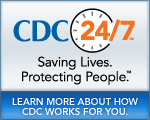MMWR
Morbidity and Mortality Weekly Report
MMWR News Synopsis for November 26, 2008
- (Box) World AIDS Day a€“ December 1, 2008
- Progress Toward Strengthening Blood Transfusion Services a€“ 14 Countries, 2003-2007
- Multistate Outbreak of Salmonella Infections Associated with Frozen Pot Pies a€“ Untied States, 2007
There will be no MMWR telebriefing scheduled for:
November 26, 2008
(Box) World AIDS Day a€“ December 1, 2008
PRESS CONTACT: CDC
National Center for HIV/AIDS,
Viral Hepatitis, STD and TB Prevention
(404) 639-8895
No summary available.
Progress Toward Strengthening Blood Transfusion Services
PRESS CONTACT: CDC, Anna Brittain
Global AIDS Program
(404) 639-6173
In sub-Saharan Africa, the need for blood transfusions is great because of maternal morbidity, malnutrition, and infectious diseases, but the blood supply is often inadequate and potentially at high risk for HIV infection. Since 2004, CDC, through the U.S. Presidenta€?s Emergency Plan for AIDS Relief (PEPFAR), has provided support to strengthen national blood transfusion services in 14 resource-limited countries in Africa and the Caribbean with high burdens of HIV infection and this report summarizes the substantial progress made since the onset of the initiative.??Of the 80 million units of blood donated each year globally, only about 2 million units are donated in sub-Saharan Africa, where the need for blood transfusions is great because of maternal morbidity, malnutrition, and a heavy burden of infectious diseases such as malaria. The inadequacy of the blood supply in many African countries is compounded by inconsistent laboratory screening for HIV and collection of blood from donors at greater risk for HIV infection.??Since 2004, CDC, through the U.S. Presidenta€?s Emergency Plan for AIDS Relief (PEPFAR), has provided support to strengthen national blood transfusion services in 14 resource-limited countries in Africa and the Caribbean with high burdens of HIV infection. This report summarizes the substantial progress made since then in the improvement of national blood transfusion services and reduction of the risk of transfusion-transmitted HIV infection.??
Multistate Outbreak of Salmonella Infections Associated with Frozen Pot Pies a€“ Untied States, 2007
PRESS CONTACT: CDC
Division of Media Relations
(404) 639-3286
Because microwavable not-ready-to-eat foods can contain raw ingredients that require full cooking, labeling and cooking instructions on these foods should be clear and consumers should follow cooking instructions specific for their microwave ovena€?s wattage.??In this outbreak in 2007, 401 cases of salmonellosis occurred in 41 states and 32 percent of ill persons were hospitalized. An investigation identified Banquet brand pot pies as a source of the infections. This is a frozen not-ready-to-eat microwavable product.??Other Salmonella outbreaks that have been associated with microwavable not-ready-to-eat foods include chicken nuggets and breaded pre-browned chicken breasts.??Although some of these products appear to only require warming, they contain raw ingredients that require full cooking. Microwaves heat unevenly, which means that some sections of a food item may be more thoroughly heated than others. To help prevent outbreaks, manufacturers should provide clear labeling and cooking instructions on not-ready-to-eat foods to ensure that consumers are aware of health risks and to facilitate compliance with validated cooking methods. Likewise, consumers should carefully follow cooking instructions.
####
- Historical Document: November 26, 2008
- Content source: Office of Enterprise Communication
- Notice: Links to non-governmental sites do not necessarily represent the views of the CDC.
View Press Releases in
Get e-mail updates
To receive e-mail updates about this page, enter your
e-mail address:
Contact Us:
- Centers for Disease Control and Prevention
1600 Clifton Rd
Atlanta, GA 30333 - 800-CDC-INFO
(800-232-4636)
TTY: (888) 232-6348 - Contact CDC-INFO


